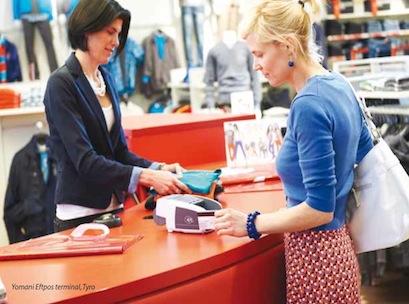Point of sale (POS) technology is changing just as rapidly as the retail industry and appears to be facing the same challenges. As new players enter the tech space, consumer demand for a seamless retail experience heightens, and the increasing trend of digital wallets continue to take over the market as signatures are phased out. So who will come out on top in 2014? One of the biggest changes in POS this year is the shift to PIN numbers. In January, the Industry Security Initiative confir
med PIN will become the main form of card payment authorisation in Australia from August.
The industry-wide move to expand PIN at POS and phase out the signature will more than likely cause some stir, mostly among older cardholders, but experts indicate the biggest impact will be felt by the food and the beverage industry.
While most locally-owned POS software and hardware providers are already prepared for the rollout across retail networks, Andrew Rothwell, co-founder of Tyro, says the biggest shake up will be seen in hospitality.
“With the introduction of this new PIN mandate, imagine how that will change the restaurant experience when customers can’t sign for the bill at the table?,” says Rothwell.
The introduction of a PIN-only system for payment ensures that a customer’s banking security remains in the hands of the consumer, as well as cutting customer waiting and transactions times.
Despite these advantages, the shift presents a challenge for the banking community and Eftpos providers who may be yet to introduce portable handheld devices.
“How many banks and POS partners have got together to provide an integrated pay at the table type of experience? That’s the question that no one really knows the answer to,” Rothwell says.
Digital wallets were the buzzword of 2013, with an array of models hitting the Australian market last year. From Paypal to Apple, Mastercard and Coles, companies across a range of markets dabbled with contactless payment solutions.
Island Pacific’s co-founder, David Tyc, says the use of mobile devices will be further adopted by Australian retailers this year.
“It was more of a trend last year, but this year it’s becoming the norm as to what POS will look like from a hardware perspective,” says Tyc.
“Hardware providers are all in that tablet/smart device space, whereas five years ago it was PC-based solutions.”
Despite most experts agreeing that mobile wallets have picked up more rapidly in the US compared to Australia, most will be eagerly awaiting the local reception of Paypal Beacon.
Expected to launch later this year, Paypal Beacon allows customers with the Paypal app to pay instore with their smartphones hands free.
“Once you have customers paying with their phones you’ve got new and exciting ways you can engage with them,” Vaughan Rowsell, CEO of Vend, told Inside Retail Magazine.
“Everyone is still shaping their thinking around [smartphone payments] because it’s an opportunity that retailers have never had before.
Retailers should also be keeping an eye out for US-based payment system, Square.
The brainchild of Twitter co-founder Jack Dorsey, Square is set to make waves when it lands on Australian shores later his year.
Since being adopted by some big name retailers in its home market, including Starbucks, the iPad-based solution has launched in app form: Square Wallet.
Rothwell says processes like Square – low cost systems that integrate all channels of the business into one device – will become more popular in Australia over the next two years.
“This is certainly something that we’re going to see a little more of in Australia as the years go by.
“We may not see it big time in the next 12 to 24 months, but I think there will be a class that will find that technology useful.”
But is it a blessing or a curse that Australian consumers are quickly becoming spoilt for choice when it comes to digital wallet systems?
“There are many wallet providers,” says Rothwell.
“There is massive competition at the moment with everyone trying to become ‘the one’. From what I can see, I think there is confusion at the moment from the customer’s standpoint as to which is the wallet to use.
“There will definitely be consolidation in that market space within the next couple of years.”
Sky high expectations
In 2013, the retail world was also abuzz with talk of ‘the cloud’, and it seems it will remain a huge trend this year.
“Small businesses are heading 100 per cent to the cloud,” says Rowsell.
“Gone are the days of installed software. We’re well into the majority of businesses using cloud- based computing, and that’s being driven by the cost effectiveness of it and security.”
Rothwell agrees: “Merchants are now able to have confidence that software providers are really taking care of their data, whereas in the past people didn’t pay too much attention to customer data, and that’s even more important in the banking industry.”
In the US, Target’s recent POS security breach potentially affected more than 40 million customers who made purchases by swiping their cards at terminals during the peak holiday season.
The data breach reiterates to retailers worldwide how important it is to have secure and up to date systems in place.
“Target’s data breach just shows you how old and how vulnerable some of the systems are, and how urgently in need of fixing some of them are,” says Tyro’s Rothwell.
“The same story is essentially true for CRM systems that are backing the POS systems.”
Along with the cloud, another major trend in POS technology carried over from 2013 is the increasing use of the tablets.
According to Jason Pang, marketing manager of Toshiba, the footprint of POS hardware in Australia is continually getting smaller – similar to the US.
“I would say Australia is more comparable to the US market. When we launch a product it either launches in the US or Australia first,” Pang said.
“Australia has always been at the forefront of POS technology compared to Asian countries. In Asian markets a lot of merchants are still using the traditional cash register.”
Pang says the company is seeing a significant shift to smaller tablet-like devices.
“POS technology in Australia has shifted to tablet size as a lot more [retailers] are using iPads.We will be launching a couple of new models in the next two to three months involving tablets.”
Tablets are also being quickly adopted by local retailers as personal digital assistance (PDA) devices.
Electronics retailers, such as Apple and JB Hi-Fi, and luxury fashion houses commonly use tablets in Australia to check stock availability and location.
Handheld tablets for floor staff are ideal for retailers wanting to make an instant sale or check inventory throughout the chain’s network, however, Rothwell recommends tablets should only be used transactionally during peak shopping periods such as Christmas and Easter to eliminate waiting times for customers.
“Some merchants that want to provide high touch services to their customers are now able to do so using tablets. They can walk out on the sales floor, help the customer, check stock, and even make a sale,” Rothwell says.
“A lot of high end merchants that want high touch will direct their customers back to a countertop to have their goods properly wrapped and taken away.
“I think tablets have a right and proper place, certainly in terms of showing product to customers, and helping them make purchases, but not necessarily to take payment on the floor.”
Staying loyal
More and more loyalty programs are also being tied to POS systems, as many retailers continue to push sales via emails and social media channels to offer a seamless path to purchase.
For example, Australian retail chain, Ally Fashion, launched an instore sales campaign via its Facebook page. Customers were given $10 off their next purchase if they texted a promo code to a mobile number. Customers then received a code to redeem instore for the sale.
“This is something that we’re starting to see quite a lot. Retailers are using their social media profiles to market to their fans and engage with them – not only about the product, but also promotional offers,” says Tyc.
Last year Glue Store teamed up with technology platform, ShopReply, to allow television audiences to instantly purchase what they saw on screen via the company’s Twitter handle.
“The traditional loyalty program is a broken experience,” says Vend’s Rowsell.
“It’s a horrible experience because no one carries their loyalty cards with them, or to join up customers have to fill out a paper form instore.
“What we’re starting to see is loyalty programs for retailers becoming seamless. It could be as simple as a customer checking in on Facebook and then being rewarded for it.”
On the end of the social media spectrum, local e-tailer Esther Boutique recently created a promotional campaign using instant photo sharing app, SnapChat. Customers were encouraged to SnapChat to the retailer’s account and in return were given a $10 voucher off their next purchase.
Rowsell says social media partnered with an effective and seamless loyalty program also has the pulling power to bring in new customers.
“If retailers have an amazing product, brand, and give an amazing experience, that customer is going to want to come back. So, it then really becomes about how do retailers get new customers, and that’s where social is super powerful,” says Rowsell.
“Once you’ve discovered that customer, you’ve created an experience, and they love your product. So how do you future proof those customers and get them to come back and also tell their friends?
“It’s not rocket science, it’s retail 101. The technology should almost be out of the way.”
This article first appeared in Inside Retail Magazine’s February/March 2014 issue. to subscribe, click here.







